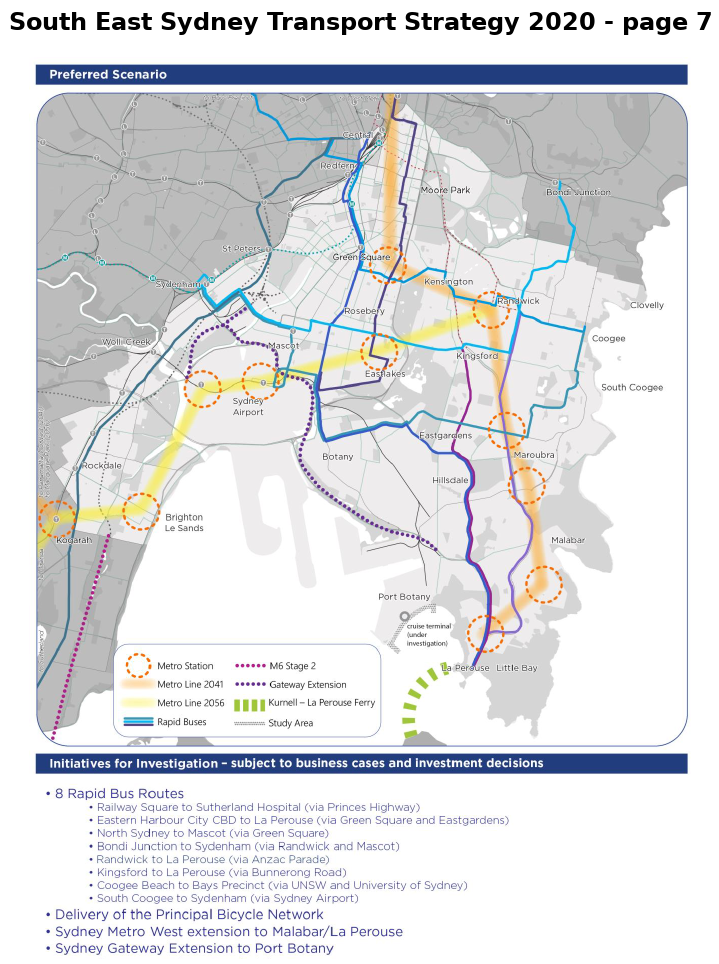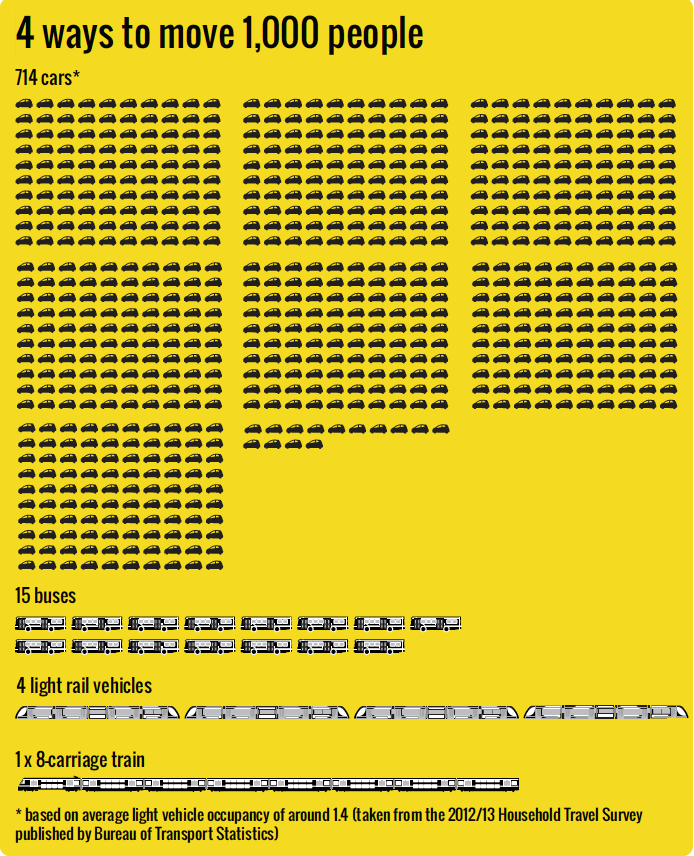

| Action for Public Transport (N.S.W.) Inc. |
| P O Box K606 |
| Haymarket NSW 1240 |
| 30 June 2021 |
Who we are
Action for Public Transport (NSW) ("APTNSW") is a transport advocacy group active in Sydney since 1974. We promote the interests of beneficiaries of public transport; both passengers, and the wider community.
Key points
As they stand, the proposed changes to the eastern suburbs bus system would in many cases:
These outcomes are at odds with strategic directions on climate change and city planning, as well as with the TfNSW motto "we put the customer at the centre of everything we do."
The government recently announced a proposal to continue the West Metro from the CBD through to Randwick and Kingsford, with a spur line to Malabar, which we applaud (South-East Sydney Transport Strategy August 2020). Major changes to the bus system should be postponed until passengers have the opportunity to interchange with both light rail and metro.
Starting point
The EIS for the CBD and South East Light Rail ("CSELR") (Volume 2) noted the strength and importance of the existing bus system serving Sydney's South-Eastern suburbs:
Outside of the CBD the proposed CSELR project will operate through the South Eastern suburbs where buses are currently the primary public transport mode. This corridor is within Transport for NSW's Metropolitan Bus System Contract (MBSC) Region 9 which is the most heavily patronized bus region in the Sydney metropolitan area (p.60).APTNSW would support changes to the bus/CSELR system if, and only if, they constitute an improvement, and meet the promise made on the TfNSW website to "put the customer at the centre of everything we do". As they stand, however, the current proposals would not meet these benchmarks in many respects. We believe a substantial reconsideration is in order.
Strategic Context
Any move that discourages the use of public transport is contrary to the strategic directions indicated in critical government policies and plans.
Climate change
Carbon emissions from transport are second only to those attributable to energy production. The State's Climate Change Policy Framework, with its target of zero net emissions by 2050, is intended to set NSW up as a leading and competitive low-carbon economy.
The Minister recently announced the progressive electrification of the public transport fleet, and we congratulate him for this. Realistically, it will be many years before the private vehicle fleet follows suit. Maximising patronage on public transport therefore remains central to the task of reducing CO2 emissions.
City shaping
Future Transport 2056 and its companion documents (Greater Sydney Services and Infrastructure Plan, Regional NSW Services and Infrastructure Plan, Greater Newcastle Future Transport Plan) recognise the strategic role played by public transport in shaping cities and making them work efficiently. Future Transport 2056 notes that "Transport for NSW aims to increase the mode share of public transport services and reduce the use of single-occupancy vehicles"(p.47).
The Strategy proposes to completely alter the way in which frequency is addressed. The Greater Sydney Services and Infrastructure Plan proposes to deliver services and infrastructure that enable 30-minute access to the nearest Metropolitan City Centre or Cluster - in the case, the Harbour CBD (Sydney CBD). (https://future.transport.nsw.gov.au/plans/greater-sydney-services-and-infrastructure-plan)
In August 2020 the South-East Sydney Transport Strategy was released. It says on p.1
The Strategy has translated the City Shaping and City Serving corridors in Future Transport 2056 into potential future networks for detailed investigation and economic assessment. The Strategy also recommends land use and policy opportunities to drive more sustainable movements and more successful places.An important element of the Strategy is the proposal to continue Sydney Metro West from Hunter St in the CBD through to Randwick and Kingsford, with a spur line to Malabar. APTNSW fully supports this proposal, which would link two major hospital precincts and many employment centres, and make them accessible to people living across a large segment of Sydney.
Forced interchanges
The proposed changes would move the bus system away from providing direct connections to the CBD, relying instead on interchanges with a smaller number of CBD bound bus routes and with light rail (at Randwick and Kingsford). For example, the 390X would go to Bondi Junction instead of straight to the city; city-bound passengers would have to interchange at Kingsford.
Grids and webs
APTNSW appreciates that interchanging between vehicles cannot be entirely avoided in highly developed urban public transport systems. The secret to catering for diverse trip patterns is to increase the coverage of the public transport network, design it as a web of interconnecting routes, and run services at high frequencies1. This maximises access from any point to any other point on the web (a modified grid), and creates "network effects" (higher patronage across the whole network). This is the underlying system design principle for the very popular Metro Bus system. It is also how exemplary systems such as those found in Paris and Tokyo work.
The absolute need for high frequencies, indeed very high frequencies, must not however be overlooked. European and Japanese systems offer high frequency to high frequency, under cover transfers, including at night. These are not "nice to have" features; they are fundamental elements of these systems.
Long waiting times and journey times
A public transport system reliant on transfers must offer turn up and go frequencies all day and well into the evening, every day. Otherwise, waiting times and total journey times will blow out and deter patronage.
The map of the proposed new system classes routes bus routes as "frequent" if they run every 20 minutes. This is certainly at odds with passenger experience. It is also at odds with the draft Greater Sydney Services and Infrastructure Plan (p.7), which quite rightly does not portray a service every twenty minutes as "frequent".
'Turn-up-and-go' services are planned on both city-city and centre-centre corridors. This means that once customers reach their nearest main station or stop on a trunk corridor, they will not have to wait any longer than 5 minutes across the day and in the evenings.This table (Figure 22) appears on p.46 of the Draft Greater Sydney Services and Infrastructure Plan.For people living within ~10km of our Metropolitan Centres as well as on local corridors, customers will have access to high frequency services (at least every 10 minutes) that will enable them to reach their nearest Strategic Centre within 30 minutes or to connect to a nearby trunk corridor, where they can continue their journey.
| Service type | All-day frequency |
|---|---|
| City-city | Turn-up-and-go (<5 mins) |
| Centre-centre | Turn-up-and-go (<5 mins) |
| CBD mass transit | High frequency (<10 mins) or on-demand |
| Local | High frequency (<10 mins) or on-demand |
Long walking distances
The progressive elimination of bus stops to accommodate left hand turns by general traffic (much of it single-occupant) has increased walking distances across the Sydney bus system. It has also made interchanging more difficult.
An example can be seen at Elizabeth St in the city, which suffered a wholesale removal of stops a few years ago. Recent changes to the bus network have left passengers using Victoria Rd services with a walk of several blocks to a bus stop where they can transfer to a bus serving destinations on the eastern side of the city.
This situation will worsen if the Eastern Suburbs bus system changes proceed, leading to fewer buses running on Elizabeth St.
Poorly served destinations
The proposed changes would lead to big gaps in service coverage, leaving significant destinations much less accessible by public transport. Bunnerong Rd would have no services, leaving people needing to attend services or visit graves at the cemetery with no option but private transport or taxis (which many will find beyond their means).
South of Maroubra Rd there will be no direct services to the CBD except the X buses, which run along Elizabeth Street. There is no indication that these services would be extended to run all day.
Light rail does not run anywhere near Taylor Square, Oxford St, Albion and Foveaux St. These are important precincts, which include St Vincent's Hospital and its associated medical facilities.
The Moore Park area is on the light rail route, but there are considerable distances between light rail stops, and not enough stops in the area to provide comparable levels of accessibility. There is only one light rail stop at Moore Park and, surprisingly, there is no stop where the Randwick and Kingsford lines meet.
West Metro extension
As noted earlier, the South East Sydney Transport Strategy (August 2020) includes a proposed extension of the West Metro from city (Hunter St) through to Randwick and Kingsford, with a spur line to Malabar. Depending on the exact route adopted, and the spacing of stations, this could overcome the problems evident in the proposed reconfiguration of bus routes outlined in this submission. Passengers currently using buses would have the opportunity to interchange with either light rail or metro at a number of potential hubs.
APTNSW believes that major changes to the eastern suburbs bus system should be considered in conjunction with consideration of the Metro route, as well as consideration of with light rail services. This would be entirely reasonable and consistent with Future Transport 2056, which foreshadowed service changes to connect to new train lines. At the moment, the proposed changes are premature.
Perhaps the most urgent task would be to identify a station site around or under PoWH/UNSW and incorporate a station box into the current construction. Indeed, the whole metro corridor should be identified now and protected.
Conclusion
APTNSW is grateful for the opportunity to comment on proposals to radically alter the Eastern Suburbs bus system. We hope to see the proposals withdrawn and reworked in conjunction with firm plans to extend Metro West across the Sydney CBD to Randwick and Malabar.

